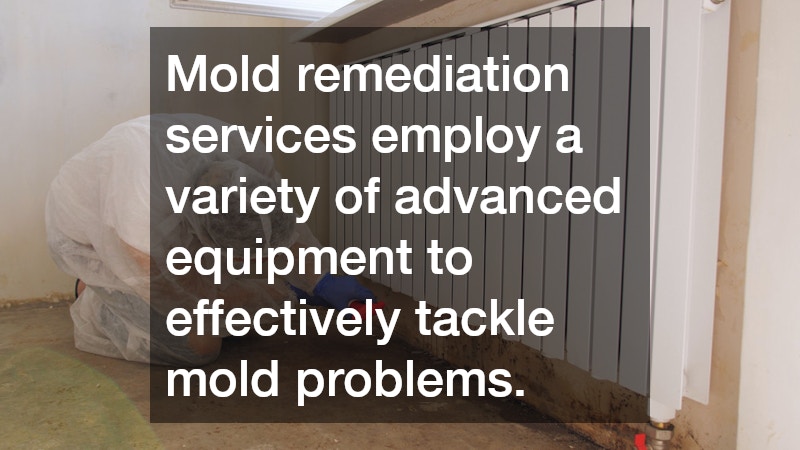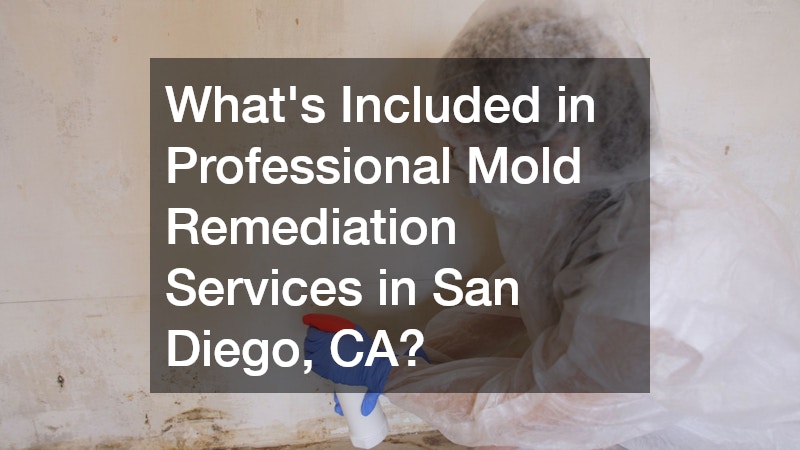In San Diego, with its unique climate conditions, mold cultivation can become a persistent issue. Therefore, having a comprehensive understanding of mold remediation processes can significantly reduce long-term damage and associated costs.
Professional mold remediation services offer specialized solutions designed to tackle and prevent these issues effectively.
This article aims to clarify each stage of the process, helping you make informed decisions about mold remediation in your home or business. By addressing common concerns and demystifying procedures, we hope to empower you to maintain a healthy and mold-free environment.
How Does the Mold Remediation Process Work?
The mold remediation process typically begins with a thorough assessment of the affected areas. Professionals use specialized equipment to detect moisture levels and the extent of mold growth, even in hidden areas such as behind walls. This initial assessment is crucial for developing an effective remediation plan tailored to the specific needs of the property.
Once the extent of the mold problem is understood, the next step involves containing the affected areas to prevent the spread of mold spores. Professionals may use specialized barriers and negative air pressure to ensure mold spores do not travel to unaffected areas of the property. Effective containment is a critical component in a successful remediation process.
After containment, the actual removal of the mold takes place. This step may involve removing and disposing of mold-infested materials such as drywall, carpeting, and insulation. Post removal, experts implement cleaning and sanitization procedures using antifungal and antimicrobial treatments to eliminate any remaining mold spores, ensuring the area is safe for occupancy.
What Equipment and Techniques Are Used in Mold Remediation?
Professional mold remediation services employ a variety of advanced equipment to effectively tackle mold problems. One of the primary tools used is the HEPA vacuum, which is essential for capturing mold spores during the cleaning process. HEPA filters are highly efficient at trapping fine particles, ensuring a safer environment post-remediation.
In addition to HEPA vacuums, air scrubbers equipped with HEPA filters are often used to cleanse the air of mold spores. These machines circulate clean air back into the space while filtering out contaminants, significantly reducing airborne mold spores and improving indoor air quality. This step is vital in mitigating the risk of future mold growth by addressing mold present in the air.
Professionals may also employ techniques such as dry ice blasting for mold removal, especially in hard-to-reach areas or on porous surfaces. This method allows for effective cleaning without damaging the underlying structures. These specialized techniques ensure that mold removal is thorough and minimizes the chances of recurrence in the treated areas.
How Long Does Mold Remediation Take?
The duration of mold remediation varies based on several factors, including the extent of the mold infestation and the size of the affected area. Generally, a straightforward mold remediation can take between one to three days. However, more severe cases involving structural damage or complex containment needs might extend the process.
Another factor influencing the timeline is the type of materials affected. Porous materials, which are more challenging to sanitize thoroughly, might necessitate additional time for removal and cleaning. Additionally, the need for drying and dehumidification processes can extend the duration, especially in areas with high moisture levels.
For homeowners and businesses, it is essential to work with experienced professionals who can provide an accurate assessment of the project’s timeline. They should be able to explain the remediation steps and offer a realistic estimate, allowing for better planning and minimal disruption to daily activities.
How Can I Prevent Future Mold Growth?
Preventing future mold growth requires a proactive approach to controlling moisture in the environment. Regularly inspecting potential problem areas such as bathrooms, kitchens, and basements for leaks or excessive humidity can significantly reduce mold proliferation. Installing dehumidifiers and ensuring proper ventilation are effective strategies in maintaining optimal moisture levels.
Regular home maintenance also plays a critical role in mold prevention. Addressing leaks as soon as they occur, ensuring proper drainage away from the foundation, and cleaning gutters regularly can mitigate moisture accumulation. These steps, combined with annual property inspections, can catch minor issues before they develop into mold problems.
Furthermore, implementing mold-resistant products during renovations can provide an extra layer of protection. These products, such as mold-resistant drywall and paints, can offer additional resistance to mold growth, making them worthwhile investments for long-term mold prevention.
Conclusion
Professional mold remediation is vital for maintaining a healthy environment in San Diego, CA. By knowing the signs of mold issues and understanding the remediation process, homeowners and businesses can better ensure the safety and cleanliness of their living or working space. Regular maintenance and proactive measures play a crucial role in preventing mold growth, while professional services guarantee efficient and comprehensive solutions when mold problems arise.
The benefits of engaging professional mold remediation services include the peace of mind that comes with knowing a space is free from harmful mold infestations. With expert guidance, residents and business owners can take effective steps toward preventing mold and maintaining a healthier environment.
Investing in mold remediation and prevention not only protects property values but also enhances quality of life by ensuring clean and safe indoor environments. By understanding the process and employing preventive strategies, San Diegans can lead healthier, mold-free lives.

